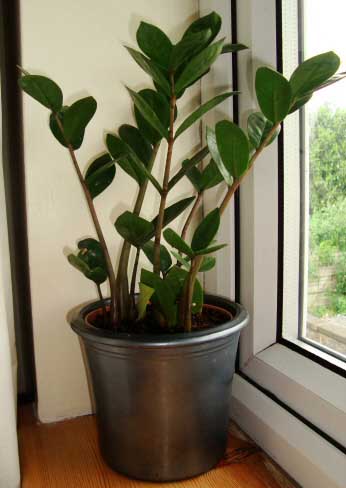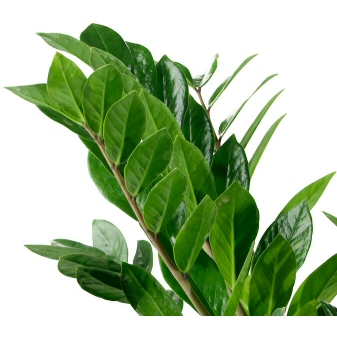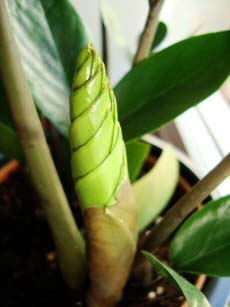





Zamioculcas Zamifolia or the ZZ plant (say Zee-Zee) is quite an exciting house plant. This is because at the time of writing, the ZZ plant is the newest house plant to enter our homes. It only started to be grown in mass by  Dutch nurseries (which is where the majority of the western worlds house plants come from) in the late 1990's and has gradually become more and more popular.
Dutch nurseries (which is where the majority of the western worlds house plants come from) in the late 1990's and has gradually become more and more popular.
The advantages of this fresh introduction to the world of house plants is that it's currently in vogue, blending perfectly well both within a contemporary and traditional setting. The ZZ Plant is stylish, attractive and easy to take care of, with an easy and straight forward propagation method. It can take a reasonable amount of neglect without adverse effects and appears impervious to the majority of pests which can afflict other plants. What's not to love about it?
The disadvantages are that you will currently only be able to find one cultivar, which is the all green variety. Sometimes going by the name Eternity Plant it can also be difficult to find and consequently may attract a high premium by way of its selling price. In addition it has an annoying tenancy to not do anything. At all. It doesn't grow, it doesn't die. It just sits there. For some people this wont matter in the slightest, but a lot of keen gardeners and indoor plant owners like feedback from their plants. When things are right they grow and flourish, when conditions aren't so good the plant lets you know about it through its sickly appearance  and in that respect the ZZ plant can be a difficult and frustrating enigma.
and in that respect the ZZ plant can be a difficult and frustrating enigma.
On balance however, the Our House Plants.com team love it. Although all parts of Zamioculcas are toxic, it's a versatile and stunning plant with a lot going on, from its starchy potato like rhizomes at the base of each stem to the oval shaped glossy leaves which are arranged along its contrasting colored stem in a herringbone fashion. It's also ridiculously simple to propagate more plants! If you're finding it hard to find a ZZ Plant you can buy them from Amazon.
Light
The ZZ plant will accommodate a broad spectrum of light conditions, however it doesn't like harsh direct sunlight found in South facing windows. Early morning, or late afternoon sun is acceptable, therefore try to aim for a North, East or West facing window. Deep shade must also be avoided if you want it to grow.
Watering
You must take care here, the number one cause of plant death is overwatering. The ZZ plant is adapted to surviving droughts, therefore heavy constant watering without allowing the soil to dry out inbetween, will turn the leaves yellow before rotting the tubers away. On the other hand for productive and fast growth the soil needs to be moist for the majority of the time between late Spring to early Autumn / Fall.
As a basic guide, in good light and warm temperate conditions, aim for a heavy watering once a week or so and slightly less in poor light conditions and over Winter. Adapt accordingly based on how the soil feels, obviously if it's still very moist when you come back a week later don't water.
Humidity
Not important.
Feeding
If the plant isn't growing, i.e. if it's in one of its "moods" (see introduction above and problem section below) or in Winter don't bother feeding. Even when it's growing, a weak feed once a month is more than adequate.
Temperature
To survive the plant needs an average spot, 13 °C - 26 °C / 55°F - 79 °F. Warmer temperatures in the upper range however will give an increase in growth output.
Repotting
Repot if needed in Spring / Summer.
Propagation
It's really easy to propagate more ZZ plants through leaf cuttings, but it will be a while before you'll see results. You could be waiting up to a year before anything happens above ground. If you have the patience though go ahead.
It's really easy to propagate, but you could be waiting up to a year before you have a new plant
All you need to do is gently pull off a leaf from the stem, allow the raw edge to dry slightly (few hours to a day) and then pot it up in a free draining compost mix with the raw edge going in first. Most of the leaf needs to be above the ground which prevents rotting, and allows for photosynthesis to take place which in turn creates the new growth. Only a few centimeters of the leaf needs to actually be in the soil, just enough to hold it in place. Keep warm and water very occasionally.
If you want a visual guide to this propagation method we found the one below on YouTube which is pretty good (avoid the type of biodegradable carton she is using though as it may have decomposed before you get results!).
After you've done this one of three things will eventually happen;
Speed of Growth
 Slow to moderate. Warmer temperatures tend to result in more growth overall. The new stems emerge out of the soil and quickly get taller before opening up, just like a cocoon. Inside are all the new glossy leaves this shoot will produce which will gradually emerge and fan out.
Slow to moderate. Warmer temperatures tend to result in more growth overall. The new stems emerge out of the soil and quickly get taller before opening up, just like a cocoon. Inside are all the new glossy leaves this shoot will produce which will gradually emerge and fan out.
Height / Spread
The stems can grow to 60cm / 24. It's spread however is limited only by the size of the container it's in, very wide containers will result in a bushy plant (after many years).
Flowers
Yes, but they are basic and not really of interest (see gallery for pictures).
Anything else?
The leaves may become dusty, popping it in a tepid shower will help wash all the leaves quickly. Do not use leaf shine products, this can be harmful and the leaves are very glossy naturally anyway.
Copyright © www.100flowers.win Botanic Garden All Rights Reserved